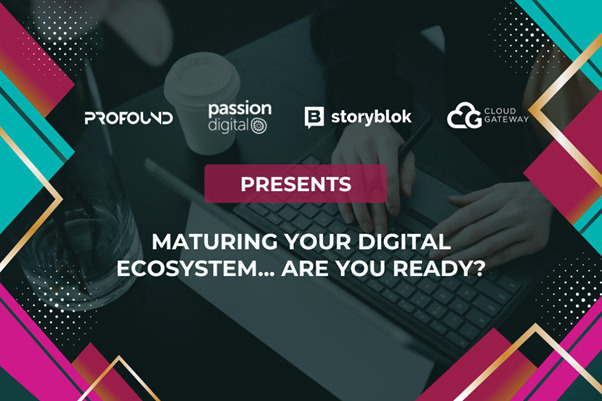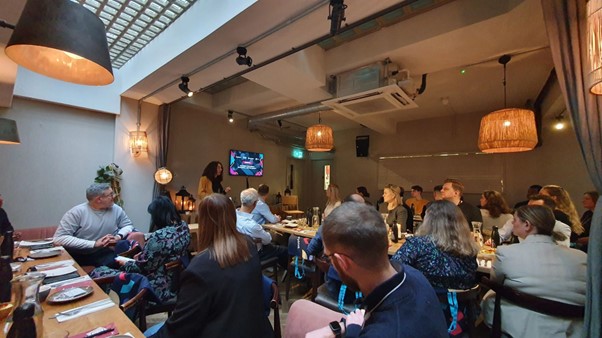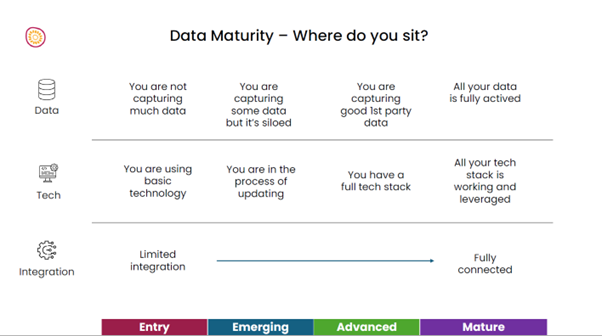
With the digital landscape constantly evolving, businesses must prioritise staying ahead of the game to achieve success. Recognising this need, we recently hosted an event that delved into maturing your digital ecosystem, where industry experts shared their insights on how businesses at every stage of digital maturity can take advantage of the latest tech to elevate their digital presence. Our experts touched on tech stack essentials that you need for different levels of marketing activity, from the bare essentials when activating activity, to large, multinational, complex businesses that require sophisticated multichannel strategies.
Our event, held at the bustling Caravan Fitzrovia brought together a panel of esteemed speakers and although we can’t capture everything covered in the event in this blog post, we’ve pulled out a few of the main insights to help your digital growth strategy.

What Is a Digital Ecosystem?
A digital ecosystem is a complex network of interconnected digital technologies, platforms, people and data that interact with each other to create value. It’s inspired by natural ecosystems, where different organisms rely on and influence each other. Here are some of the key characteristics of a digital ecosystem:
- Interconnectedness: Different elements within the ecosystem (software, hardware, data, users) work together and exchange information
- Openness: Digital ecosystems can be open or closed. Open ecosystems allow for participation from various players, while closed ecosystems are more restricted
- Adaptability: They can evolve and change over time to meet new demands and technological advancements
- Value creation: The ultimate goal of a digital ecosystem is to create value for its participants
The Changing Digital Landscape
The event started with an exploration of how user journeys are shifting and how the search funnel is increasingly involving more and more channels. Automation and AI are becoming interwoven within the search and digital experience and marketers need to ensure they have strategies to cope with the change in the way that users are searching. With all the new technologies and channels emerging, it is difficult for brands to keep up, but it was stressed that marketers need to focus on the elements they can control: getting their website marketing-ready and collecting the right data to train Machine Learning (ML) models.
The Importance of Understanding Your Data Maturity
Marketing is evolving and the use of AI, ML and automation in general is an exciting time for the industry. However, these technologies are only as effective as the data that we feed them. Each business has its own data setup, but it’s important for businesses to map out where they are on the data maturity spectrum to be able to see what the next step is for them to grow.

So, what should your MarTech stack look like to give you the best campaign chances? Well, the answer is: it depends.
As frustrating as that answer can be, the first stage your business should take is understanding what information you need to gather for the level of marketing maturity you want. A small business with a small Marketing team will have very different requirements to a multi-national company running multiple channels at the same time. Our expert Alex Hoffmann, Managing Partner at Passion Digital, has outlined what a good MarTech stack could look like for businesses at ‘Entry’, ‘Emerging’, ‘Advanced’ and ‘Mature’ stages.
An ‘Entry’ level business’ ideal MarTech stack
- Using media data from Google Ads, LinkedIn, Meta and so on to measure clicks, impressions, rankings, traffic and enquiries
- Pulling in media data to an analytics system such as Google Analytics to calculate Cost Per Lead (CPL)
- Using tools like Excel as a CRM to store sales and revenue data
- Platforms like Mailchimp may be used for email marketing
Importantly, the only joined up parts of the above stack would be the media and analytics data, otherwise data is stored in silos and there’s not much crossover.
An ‘Emerging’ business’ ideal MarTech stack
- Media and analytics data is joined up
- Analytics data is pulled into a bespoke reporting dashboard such as Google Looker Studio
- CRM data and email marketing is still in its own silo
At this stage of maturity, you may be running multiple channels and require a quick view of the activity you have running and its performance which a dashboard like Google Looker Studio provides.
An ‘Advanced’ business’ ideal MarTech stack
- Media and analytics data is not just joined up, but you’re feeding analytics data back into media platforms to refine and optimise campaigns
- Analytics data is pulled into a bespoke reporting dashboard
- You use a more sophisticated CRM tool such as Salesforce which not only stores sales and revenue data, but also categorises Marketing Qualified Leads (MQLs) and Sales Qualified Leads (SQLs). This CRM data is also passed back into other areas of your MarTech stack including into your media platforms to refine and optimise campaigns
- You continue to use tools like Mailchimp for email marketing but sync this with your CRM to continually enrich the data
- You use telephony and chat tools like Infinity to pull in qualitative and quantitative data from phone calls made to your business and pass this data back into your analytics to refine and optimise your campaigns
To achieve the above MarTech stack, you’ll need a connector like Funnel to bring the disparate tools you’re using together to holistically manage and measure your activity.
A ‘Mature’ business’ ideal MarTech stack
There isn’t really a cap on where you can go with maturing your MarTech ecosystem, however the below gives an idea of what an ‘Advanced’ MarTech stack could look like.
- Media and analytics data is not just joined up, but you’re feeding analytics data back into media platforms to refine and optimise campaigns
- Analytics data is pulled into a bespoke reporting dashboard
- You use a more sophisticated CRM tool such as Salesforce which not only stores sales and revenue data, but also categorises MQLs and SQLs. This CRM data is also passed back into other areas of your MarTech stack including into your media platforms to refine and optimise campaigns
- You don’t just run the odd email marketing campaign, but use tools like Salesforce to automate your marketing on a larger scale
- You use telephony and chat tools like Infinity to pull in qualitative and quantitative data from phone calls made to your business and pass this data back into your analytics to refine and optimise your campaigns
The Changing Expectations of the B2B Buyer
The panel also delved into the changing profile of the B2B buyer, with millennials and Gen Z’ers entering the decision-making authorities in B2B firms. These buyers are digital natives, preferring to transact online, not just for purchasing products but also services.
Highlighting the importance of understanding the new B2B buyer, our agency partner Profound – a digital design agency – drew out a few facts on just how much this buyer has changed:
- 66% of B2B buyers prefer remote human interactions or digital self-service rather than one-to-one sales talks
- 73% of B2B buyers want a personalised B2C-like experience
- 74% of millennial B2B buyers switched vendors for improved consumer-like experiences

Don’t Undergo a Digital Transformation in a Silo
When commencing your journey towards a better, more effective digital ecosystem, it’s important to involve the entire business. There have been a lot of companies that have undertaken digital transformations that have failed because they carried it out without involving the entire business. Tech is only useful if people use it and know how to use it. If an organisation doesn’t feel comfortable with the change, then the tech you’re trying to implement will fail.
Maturing Cloud Gateway’s Digital Ecosystem
We also had one of our clients come to speak at the event: Myles Clarke, Head of Marketing at Cloud Gateway, a network and security company. Myles explained Cloud Gateway’s own journey towards digital transformation, providing top tips on what to look out for and what they wished they had known before starting.
Understanding your audience
- Know your audience’s preferences, behaviours and expectations
- Utilise data, analytics and customer feedback to create personalised and targeted digital experiences
- Personalisation builds stronger connections, fostering brand loyalty
- Utilise traditional B2C tactics within a B2B context
Cloud Gateway did a big piece of customer research to understand what their audience liked, disliked and wanted from brands like them and why they needed/wanted that. Even when you’ve been working in your space for a number of years, you never know your customers as well as they know themselves, so it’s best to ask them and speak to them directly to get a better view.
Integrated data management
- Centralise and integrate your data sources
- A unified data approach allows for a holistic view of customer interactions
- Leverage CRM systems to streamline data and enhance customer understanding
Like many businesses, Cloud Gateway was guilty of having a hugely complex data stack that wasn’t integrated. Therefore, they commenced a digital transformation project, but again fell into the trap that many businesses do, of putting a hard start and end date to the project. They now see digital transformation as an ongoing process which allows them to tackle each tech area of the business to move closer to an integrated data stack.
Embrace an omnichannel strategy
- Adopt an omnichannel approach for a seamless customer journey
- Ensure consistency across all digital channels (website, social media and mobile apps)
- Customers should have a cohesive experience regardless of the platform they choose
Understanding who is visiting any area of Cloud Gateway’s digital ecosystem was hugely important for them to make sure they could optimise campaigns across channels in the best way.
Prioritise UX
- Invest in intuitive and user-friendly design
- Enhance website and app navigation, optimise page load times and ensure mobile responsiveness
- A positive UX fosters customer satisfaction and encourages repeat engagement
At Cloud Gateway, they recognised the skills that they had inhouse vs. what they didn’t. Therefore, they outsourced the dev work to ensure that Cloud’s customers had the best experience using their platform.
Leveraging emerging technologies
- Stay ahead with innovative technologies
- Explore AI, AR, VR and IoT to enhance customer interactions and differentiate your brand
- Tech advancements can offer unique and memorable experiences
Cloud Gateway has the goal of being able to use technology to automate processes without the team itself having to get too involved.
Content is king
- Develop high-quality, relevant content from legitimate thought leaders or subject matter experts
- Founder-led marketing
- Engage your audience with valuable, shareable content that aligns with your brand message
- Consistent and compelling content builds brand authority and trust
It may seem like a bit of a cliché, but the second bullet point in particular is super important for Cloud Gateway. They have a great Founder with a big personality, so leveraging that in marketing was key for them. Myles placed a large emphasis on thought leadership as it presented a great opportunity to tick the E-E-A-T (Experience, Expertise, Authority and Trust) boxes that Google is placing more and more emphasis on.
Analytics and continuous improvement
- Implement analytics tools for ongoing assessment
- Regularly analyse digital performance metrics
- Use insights to refine strategies, enhance user experiences and adapt to changing market trends
Cloud Gateway admits to being guilty of ignoring the bad bits of data and instead creating its own narrative with its data. They are now working towards collecting as much data as possible to understand what data is important for them to make decisions and then boil that down to find a sweet spot for the amount of data they need to make the right decisions and not overstretch their internal resource by constantly analysing vast amounts of data. As they brought on external agencies to support, they knew that having that data was crucial to ensure they could do their best work.
We concluded the event by inviting attendees to stay tuned for our forthcoming content on how brands at every stage can ensure they have the right MarTech in place in their brand digital ecosystem in order for their marketing activity to thrive and exactly how to build upon their current level of digital activity for business growth.
As we continue to automate and grow MarTech stacks, maturing your digital advertising ecosystem, digital content ecosystem and the entire network will be imperative for success. Our maturing your digital ecosystem event was a testament to the commitment to stay ahead of the curve and ahead of our clients’ competition and we look forward to hosting more events like this in the future.
If you’re eager to learn more and apply these insights to your 2024 marketing plans, please don’t hesitate to get in touch. We’d be happy to schedule a chat with you to explore how we can help elevate your data and analytics and broader marketing strategy to drive business growth.